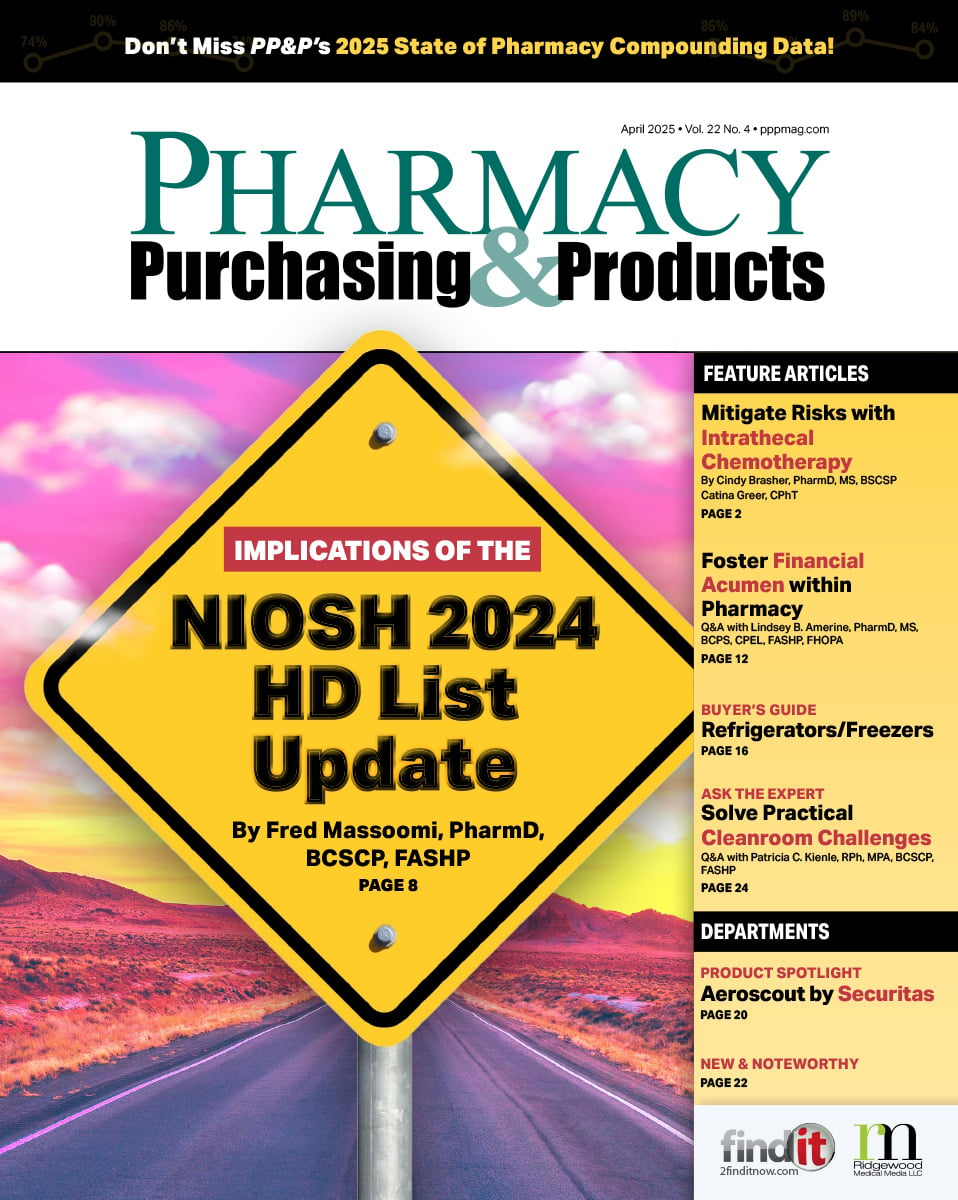- Show Menu
- Contact Us
- FAQs
- Reader Service
- Survey Data
- Survey Winners
- Testimonials
- Upcoming Events
- Webinars
- White Papers
The NIOSH Vapor Containment Protocol for CSTD Testing
FDA’s 1998 clearance of the first closed system drug-transfer device (CSTD) in the US marked a turning point toward increased safety for hazardous drug (HD) management (note: FDA clears CSTDs for marketing through the 510K process for medical devices). Prior to this, compounding and drug administration personnel had no option but to use devices that were not specifically designed to protect individuals handling HDs. This was particularly risky given that drugs have variations in the physical characteristics of pH, viscosity, vaporization, and reactivity. In addition, there is often a lack of standardized pressurization of vials provided by manufacturers (ie, negative, positive, and neutral), as well as measurable contamination on the vials and packaging of the drugs being handled. Thus, the introduction of CSTDs significantly improved safety for staff handling HDs.
Multiple CSTDs, utilizing different containment mechanisms (eg, mechanical and air cleaning), currently occupy the US market (see FIGURE 1). Given the variety of CSTDs on the market, it can be challenging to establish and compare the effectiveness of the different devices at containing drug and drug vapor and preventing exposure during the compounding and administration processes. While numerous published studies have deployed different testing methodologies, a single recognized testing standard does not currently exist for CSTDs. Such a test would facilitate evaluation of the CSTDs currently available, and also assist in assessing new entrants to the market. Keep in mind that any time the individual components of a device are changed (ie, upgrades to design or materials), the revised device should undergo retesting, as assumptions of performance cannot be applied from previous iterations of a given product. When assessing reviews of these devices, it is important to consider the year the assessment was conducted, while also recognizing that manufacturers can change the materials used to make and assemble medical devices without notification.

NIOSH Efforts at CSTD Evaluation
In August 2015, NIOSH proposed an initial draft test protocol to determine the effectiveness of vial protectors to contain drug and drug vapor using isopropyl alcohol (IPA) as a surrogate marker for chemotherapy. Conducting the test on five CSTDs demonstrated variability in performance, with two products demonstrating particularly strong results. However, NIOSH received criticism as the test did not include air-cleaning devices and used a surrogate with high vapor pressure. In response, NIOSH is creating a revised protocol intended to compare all CSTDs while using a surrogate with less volatility and is asking for public comment. The protocol and posted comments can be accessed at: www.cdc.gov/niosh/docket/review/docket288a/.
It is in pharmacy and nursing’s best interest to provide robust comments for NIOSH consideration, since these devices can significantly impact the safe handling of hazardous medications and are required for cytotoxic drug administration under the proposed USP Chapter <800>.
Testing Limitations
While vapor is key to assessing a CSTD, it is not the only factor to consider. Ensuring dry connections, preventing accidental disconnections, and preventing bacterial ingress into the sterile product should also be addressed. Because swabbing critical connections with a sterile IPA swab prior to access is a standard of practice for all patient-related devices, dry connections increase safety. Minimizing inadvertent disconnections increases staff confidence in the integrity of the closed system. Minimizing bacterial ingress with a CSTD is an important medication safety consideration.
The test or tests that are developed to evaluate performance must, at a minimum, meet the currently accepted 2004 NIOSH definition for CSTD performance: “A drug transfer device that mechanically prohibits the transfer of environmental contaminants into the system and the escape of hazardous drug or vapor concentrations outside the system.”
Considerations for Providing Comments
Some potential questions to consider when evaluating the currently proposed NIOSH protocol for CSTDs include:
- Should the test be designed so that all facilities can perform it at their own site, or should the test be one that manufacturers have to complete via an independent, third-party laboratory testing facility?
- Should the test represent a “snapshot in time” of performance or should it be longitudinal and look at how CSTDs perform over an extended period of time, in order to represent a situation akin to actual practice patterns?
- Under what conditions should each CSTD be tested? Should testing be to the letter of the FDA-cleared package insert, or should there be variations in temperature and pressure included in the testing, to represent actual clinical practice? For example, consider that facilities in Denver or Salt Lake City are essentially practicing a mile above sea level. Vials filled at sea level and then punctured at a higher altitude will have a higher pressure gradient to consider than those punctured at sea level.
- Due to its small molecules and high vapor pressure, IPA was chosen as the test surrogate in the original test protocol to represent a worst-case scenario for CSTDs. Given the impossibility of predicting the physical characteristics of future HDs, should the protocol retain IPA as the surrogate test standard? With the ultimate goal of ensuring health care worker safety, should not the surrogate be as robust as possible?
- If a device cannot pass with IPA or another surrogate, should the manufacturer then be required to conduct the test on: 1) All HDs, 2) A select sample of commonly used, highly volatile HDs, or 3) All HDs for which the device will be utilized?
- Should actual drugs be used for testing in lieu of a surrogate? How should those drugs be chosen? Consider HDs that are easily sampled, are known to produce vapors, and represent a wide spectrum of drugs on the market, such as cyclophosphamide, 5-Fluorouracil, mitomycin, paclitaxel, thiotepa, and methotrexate.
- Should NIOSH also include a companion test to establish the performance of CSTDs in maintaining dry connections during the administration phase by accurately simulating the process of chemotherapy compounding? Given that HD administration via a CSTD is required for administration of cytotoxic agents in USP <800>, this would seem to be as important at the pharmacy-compounding step. As previously noted, should this test also use an actual drug, such as cyclophosphamide, 5-Fluorouracil, mitomycin, paclitaxel, thiotepa, and methotrexate, to assess drug residue at critical connection points?
- Per the NIOSH 2004 definition of a CSTD, should NIOSH also consider a bacterial ingress test?
- Should FDA and NIOSH require safety design features that prevent inadvertent disconnections?
- Once a test has been adopted by NIOSH, what is the role of FDA on the overall clearance of existing and future devices? How are facilities to interpret the test(s) and their results, and how does this information apply to the clearance of existing devices with the designation of CSTD?
- How should facilities interpret data from the NIOSH test(s) from vendors? Will NIOSH or FDA provide an integrity standard or peer-review process for reviewing studies and data prior to dissemination?
Facilities should not use the NIOSH comments on testing protocols as a means to choosing a CSTD or to guide decision-making for changing devices. The comment period is a time for industry, researchers, and frontline users to provide thoughtful observations for NIOSH’s consideration to inform the development of a standardized performance test(s). Information from the NIOSH comment site is not peer-reviewed. We would never use a drug without peer-reviewed data indicating its safety and efficacy; likewise, this same principle should be applied to medical devices. If an organization is presented with sales information from vendors based on information, comments, or research provided to NIOSH for consideration for a standardized test, the organization should proceed with caution.
Conclusion
CSTD use is critical to protecting staff compounding and administering HDs, and protecting patients by minimizing the ingress of microorganisms into sterile products. Without a single CSTD testing standard, evaluating the devices remains challenging. The final NIOSH vapor containment protocol will hopefully simplify and streamline the CSTD evaluation process.Pharmacists and nurses are urged to consider the above questions and provide their valuable input to NIOSH.

 James A. Jorgenson, RPh, MS, FASHP, is chief executive officer and chairman of the board of Visante, Inc, and Visante Limited. Before joining Visante, Jim was chief pharmacy officer and vice president of Indiana University (IU) Health, where he was responsible for the design and operation of the system’s pharmacy services supporting IU Health’s integrated delivery network. He is a member of PP&P’s Editorial Board.
James A. Jorgenson, RPh, MS, FASHP, is chief executive officer and chairman of the board of Visante, Inc, and Visante Limited. Before joining Visante, Jim was chief pharmacy officer and vice president of Indiana University (IU) Health, where he was responsible for the design and operation of the system’s pharmacy services supporting IU Health’s integrated delivery network. He is a member of PP&P’s Editorial Board. Fred Massoomi, RPh, PharmD, FASHP, is a senior director of hospital and health-system pharmacy for Visante, Inc. He received his doctorate from the University of Kansas School of Pharmacy. Fred is a member of PP&P’s Editorial Board.
Fred Massoomi, RPh, PharmD, FASHP, is a senior director of hospital and health-system pharmacy for Visante, Inc. He received his doctorate from the University of Kansas School of Pharmacy. Fred is a member of PP&P’s Editorial Board.Disclosure: Fred Massoomi, RPh, PharmD, FASHP, lectures on safe processes for handling hazardous drugs for BD, ICU Medical, Baxter, and Equashield.
Like what you've read? Please log in or create a free account to enjoy more of what www.pppmag.com has to offer.








